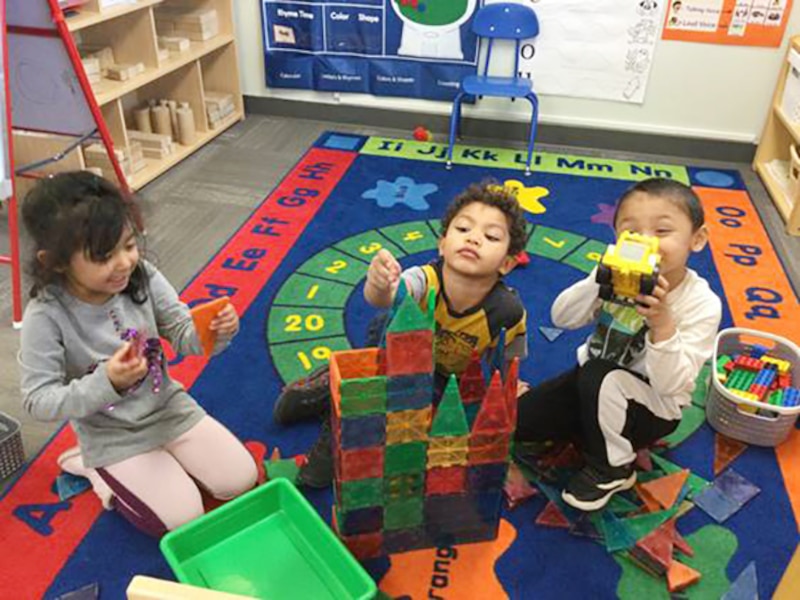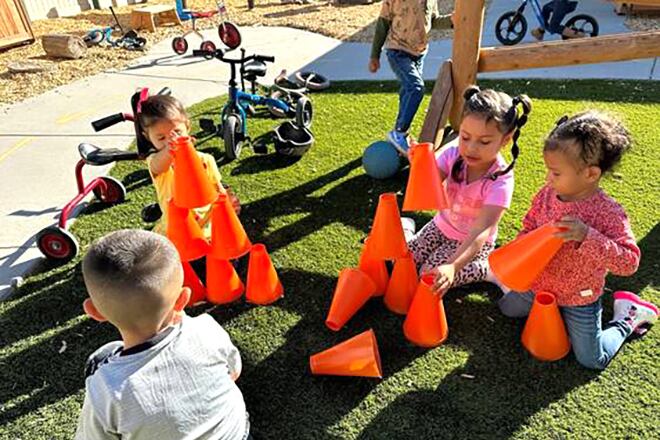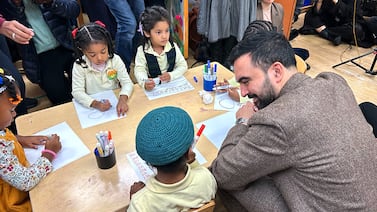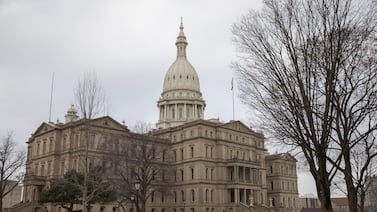Stay up-to-date on the latest news in early childhood education and development across the U.S. Sign up for Chalkbeat’s free monthly newsletter The Starting Line.
Come January, a new baby is scheduled to enroll at Angel Hugs Early Learning, a top-rated child care program in the suburbs west of Denver. Owner Sarah Hewitt is especially excited because the little boy will be her first grandchild.
There’s just one problem: Hewitt will lose about $18,000 a year by accepting the infant.
That’s because Colorado’s child care subsidy program, which helps low-income families pay for child care so they can work or attend school, is facing a major budget crunch. Although Hewitt’s daughter, who works as a teacher at Angel Hugs, will likely qualify for a subsidy based on her income, she won’t get child care aid. Instead, the single mother will land on her county’s long waitlist.
Since Hewitt doesn’t want to lose her co-teacher, she’ll give her grandson the spot for free.
The challenge Hewitt and her daughter face is playing out in states across the country now as federal COVID aid for child care expires and states gear up to adopt new federal rules aimed at improving the child care subsidy program. In many states, those twin developments mean subsidy waitlists, enrollment freezes, or tighter eligibility requirements. The bottom line is that fewer low-income families will get help paying for child care.
“We’re just going to be serving thousands and thousands less children, which is horrible,” said Barbie Prinster, executive director of the Arizona Early Childhood Education Association. “It’s a bummer for families that want to go to work.”
Advocates like Prinster worry that as subsidies become harder to get, low-income parents will drop out of the workforce or be forced to put their children in unlicensed or even unsafe care. Those decisions will ripple out to employers and the economy.
About 2 million children nationwide, most under 6, receive child care subsidies each year. The federal government provides most of the funding, with states and sometimes counties kicking in smaller amounts.
Advocates say more public funding is needed to bolster child care subsidies.
“A very wise legislator said to me once, ‘Show me your budget, and I’ll show you your values,’” said Mindy Binderman, Executive Director of the Georgia Early Education Alliance for Ready Students. “This is a time for our state legislature to … value kids and families in the workforce.”
Some experts say that while states should do what they can to boost funding for subsidies, the federal government must do the heavy lifting.
“We don’t think this can be solved by states on their own,” said Karen Schulman, senior director of state child care policy at the National Women’s Law Center. “We need significant federal investment.”
Federal rules bring positive but pricey improvements
Advocates praise the new rules from the Biden administration that must be phased in over the next two years. They’ll limit monthly co-pays to no more than 7% of a family’s income and change reimbursement policies so providers get paid before they provide care, not after, and don’t lose money when a child is absent.
The downside is that the rules come with hefty price tag, and there’s no new federal money to pay for them. President Biden’s unsuccessful Build Back Better package would have provided enough aid to cap child care costs for many working parents at 7% of household income. Vice President Kamala Harris, the Democratic presidential nominee, has made a similar pledge. It’s unclear how Donald Trump, the Republican nominee, would tackle the cost of child care.
Diane Girouard, state policy senior analyst at Child Care Aware of America, said the new federal rules are critically important, but acknowledged that states will face “difficult tradeoffs” over the short term.
Schulman said by paying providers “prospectively” — before care is provided — and basing the reimbursement on enrollment, not a child’s attendance record, the subsidy system is moving closer to how the private child care market operates.
“The goal is to have a child care assistance system look a lot more like that, so that a provider doesn’t look at the two options and say, ‘Well, why wouldn’t I just serve the private pay parent?’” she said.
That doesn’t mean the private pay market is ideal. Far from it, said Schulman, who like many experts describe child care as a broken market — too expensive for many parents even as workers get paltry wages and child care businesses survive on tiny margins.
The subsidy system, she said, “shouldn’t be providing even less stability and fewer resources than a broken market.”
States make efforts to cut caseloads
A number of states have started waitlists for child care subsidies in the last year. Oregon instituted one in November, Nevada in April, and Arizona in August. In Colorado, where the subsidy program is administered by counties, six of 64 counties now have waitlists or freezes, and state officials expect most other counties to have one or the other by June.
Typically, children from certain priority groups can bypass waitlists or freezes. In many states, these groups include children in the foster care system, the child welfare system, or whose parents receive aid through the federal Temporary Assistance for Needy Families program.
But for families outside of those groups, the outlook can be grim
Binderman said Georgia was serving 72,000 children a month while the state was flush with COVID relief money. Now, state officials say the rolls must be reduced to 50,000 children.
To get there, Binderman said, the state limited eligibility starting in September to families making 30% of the state median income — about $32,000 for a family of four. Previously, families with incomes up to 50% of the state median income qualified.
Nevada also instituted tougher eligibility requirements this fall. New families qualify for a subsidy with a household income at or below 41% of the state median income — about $39,000 for a family of four. Previously, the threshold was 85%.
Sarah Dawson, who heads Colorado’s subsidy program, said the expiring COVID aid, along with the state’s $20-million-a-year plan to boost subsidy reimbursement rates for providers, will mean a 22% decrease in the number of full-time-equivalent children the state can afford to subsidize.
That doesn’t mean families who currently receive subsidies will be kicked out of the program, but rather fewer new families will be able to enroll.
“This is what keeps me up in the middle of every night, ” she said.
Providers face ‘tough decisions’
Amy Ogilvie, who heads the Wild Plum Center in the northern Colorado city of Longmont, said she currently has 22 open slots for children who receive child care subsidies. But nobody’s coming to fill them because Boulder County, where her program is located, has been on a subsidy freeze since April.
Wild Plum enrolls 220 children, all of them from families living in poverty. Most of the funding comes from government sources, including state child care subsidies. Ogilvie said the center lost about $17,000 in child care subsidy funding this September compared with September 2023.

“As a program, we have to figure out where we’re coming up with $17,000, and if this repeats month over month over month, I’m going to have to start making tough decisions,” she said.
To pay the bills, the center could eventually be forced to increase class sizes or accept families who can afford to pay tuition, she said.
Hewitt, who owns the home-based program Angel Hugs, said without the extra funding her grandson’s subsidy would bring in, she’ll have less money to provide free parent classes on CPR or safe sleep, pay for supplies like paint and markers, or make planned improvements to encourage nature play in her backyard.
“It’s going to be tough,” she said.
States action helps, but not enough
Some states got a jump on the subsidy program changes now required by the federal government because they took action at the state level. Oregon passed a child care subsidy reform law in 2021. Before that, the state often left subsidy dollars on the table.
“Not enough families signed up for child care subsidies, or they did sign up for child care subsidy and [they] couldn’t find a provider who would take it, because it was a really crappy program,” said Dana Hepper, director of policy and advocacy at the Children’s Institute, an Oregon advocacy group.
But with a host of improvements phased in since the 2021 law — mirroring several of the new federal rules — there’s now a waitlist of more than 7,000 families, she said.
“We made all these reforms to make it a better program, and the result of that was families signed up for the program in droves and child care providers were willing to take subsidy,” she said.
Oregon lawmakers increased funding for the subsidy program this year, but it wasn’t enough to eliminate long waits for most qualifying families.
Across the country in Connecticut, state lawmakers also recently sent more money to the subsidy program.
Merrill Gay, executive director of the Connecticut Early Childhood Alliance, said state lawmakers upped spending on child care subsidies from $57 million a couple years ago to $130 million this year. The move allowed the state to clear its subsidy waitlist of about 2,000 children over the summer.
“We’ve made some real progress,” he said. “We’re far from nirvana.”
Only about 20% of eligible families are getting subsidies, he said. There’s little publicity about the program, and many parents don’t learn about it unless they call the 211 social services hotline or hear about it from their child care provider.
Gay’s solution to the perennial struggle to adequately fund subsidies is simple: “Tax rich people and pay for child care.”
He laughed, but he wasn’t joking.
“I know it’s a lot easier to say than to do, but we have, across the country, cut taxes for rich people every way we can think of,” Gay said. “As a result, government has less money to do what it needs to do.”
Ann Schimke is a senior reporter at Chalkbeat, covering early childhood issues and early literacy. Contact Ann at aschimke@chalkbeat.org.






